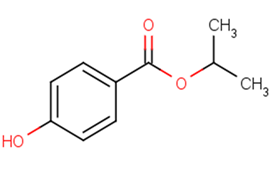
Isopropylparaben
CAS No. 4191-73-5
Isopropylparaben( —— )
Catalog No. M20342 CAS No. 4191-73-5
Isopropylparaben is a preservative and preservative insecticide.
Purity : >98% (HPLC)
 COA
COA
 Datasheet
Datasheet
 HNMR
HNMR
 HPLC
HPLC
 MSDS
MSDS
 Handing Instructions
Handing Instructions
| Size | Price / USD | Stock | Quantity |
| 5MG | 29 | In Stock |


|
| 10MG | 37 | In Stock |


|
| 25MG | 59 | In Stock |


|
| 50MG | 74 | In Stock |


|
| 100MG | 119 | In Stock |


|
| 200MG | Get Quote | In Stock |


|
| 500MG | Get Quote | In Stock |


|
| 1G | Get Quote | In Stock |


|
Biological Information
-
Product NameIsopropylparaben
-
NoteResearch use only, not for human use.
-
Brief DescriptionIsopropylparaben is a preservative and preservative insecticide.
-
DescriptionIsopropylparaben is a preservative and preservative insecticide.
-
In Vitro——
-
In Vivo——
-
Synonyms——
-
PathwayOthers
-
TargetOther Targets
-
RecptorOthers
-
Research Area——
-
Indication——
Chemical Information
-
CAS Number4191-73-5
-
Formula Weight180.2
-
Molecular FormulaC10H12O3
-
Purity>98% (HPLC)
-
Solubility——
-
SMILESCC(C)OC(=O)c1ccc(O)cc1
-
Chemical Name——
Shipping & Storage Information
-
Storage(-20℃)
-
ShippingWith Ice Pack
-
Stability≥ 2 years
Reference
1.Kim M J Kwack S J Lim S K et al. Toxicological evaluation of isopropylparaben and isobutylparaben mixture in Sprague-Dawley rats following 28 days of dermal exposure[J]. Regulatory Toxicology and Pharmacology 2015 73(2):544-551.
molnova catalog



related products
-
γ-Glu-Tyr
γ-Glu-Tyr (gamma-Glutamyltyrosine) is a kokumi peptide with competitive inhibition of dipeptidyl peptidase-IV (DPP-IV) and is used in the study of diabetes mellitus.
-
Pressinoic Acid
Pressinoic Acid is a peptide with potent corticotrophin-releasing activity. It is also an oxytocin inhibitor; it induces maternal behavior.
-
Ruplizumab
Ruplizumab (BG 9588), a humanized monoclonal IgG1κ antibody targeting CD40L (TNF Receptor), holds promise for research in systemic lupus erythematosus disease .



 Cart
Cart
 sales@molnova.com
sales@molnova.com


